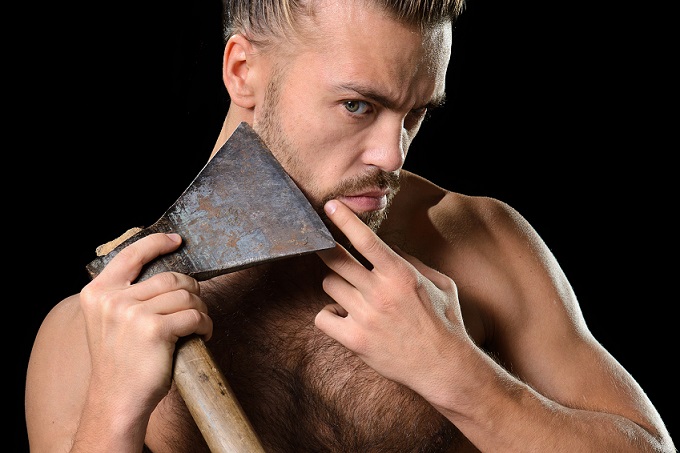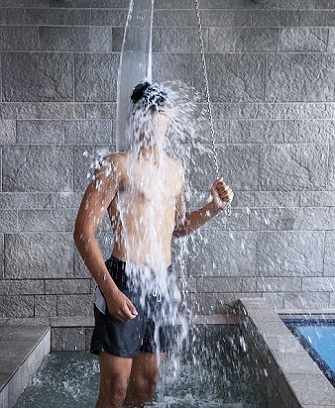 Countless acne patients have noticed that shaving causes acne, so there must be something behind it.
Countless acne patients have noticed that shaving causes acne, so there must be something behind it.
At first you would be tempted to dismiss the theory instantly. It sounds like a classic old wives tale, something along the lines of greasy food causing acne or your facial expression getting stuck if the wind changes.
However shaving can indeed make a faceful of acne worse. It most likely won’t create any new pimples, but if you do it the wrong way then shaving can make your existing acne a lot more inflamed.
This article won’t give you any regimens that take hours. You won’t have to meticulously prepare for the simple act of removing hair from your face. You will learn how to shave rapidly without losing a huge chunk of your day, and still not get pimples and acne.
Let’s get started:
My experience – stay stubbly at all times
Ever since I first started shaving, I’ve always used an electric rotary shaver. I’ve never used a disposable razor, a safety razor, or a multi-blade razor, and I’ve never once applied shaving lotion to my face. I never had the patience for the lotions or the creams. I constantly tried to shave as fast and as hardcore as I could, even making a game of it, to minimise the time lost in the day.
The problem was that the one thing I didn’t minimise was the acne and irritation. Almost every shaving session ended in my existing pimples being reddened significantly. The acne was inevitable; this went on for years. Sometimes new, tiny pimples formed in the surrounding areas, but usually it was redness and irritation, sometimes in separate areas of the skin. It was a tale which many acne patients are familiar with.
Luckily, I found a solution – I ceased to use the main razor at all and switched to the beard trimmer on the back instead. I gave up getting a clean shave every day, and trimmed the stubble to a length a few millimetres longer.
Read Annihilate Your Acne – learn how to clear your skin permanently
Doing this transformed my shaving sessions. The amount of irritation fell by 95%. The amount of close contact between the blades and the skin was dramatically reduced. From that day forth I only ever cut my acne open if I was completely mindless. With this technique my face was never smooth again, but to the naked eye, it looked like I was clean shaven.
Most importantly, I could still shave my entire face with rapid speed and not be overly meticulous. In fact, I could shave even faster. The irritation was gone forever.
In reality, I had a very rough stubble. This technique will give you a face with the texture of sandpaper immediately after completion, the perfect stubble for attacking somebody at close range.
However, what matters is that the beard trimmer shave looks almost no different to a clean shave. The only difference is in the complete lack of reddened and angry pimples. If you use a rotary electric shaver, switch to the beard trimmer razor and you’ll never look back.
The perils of multi-blade razors
With multi-blade razors, meanwhile, you have the opposite situation: the blades are far too close and even more so than the standard rotary blade. The entire function of a multi-blade razor is to dig in deep and achieve the baby face look. The first blades lift the hairs out of the skin, and the secondary blades cut the hair from below the level of the skin.
This succeeds in removing all traces of hair and smoothing the skin perfectly. However, the technique also stretches the hair strand far above its natural level.
The result is that the skin grows over the severed shaft of hair, and when it grows back, it has to push through a fresh layer of skin. Your skin becomes irritated and red, often mimicking the appearance of acne.
If you’ve ever had an ingrown hair, you’ll know what the painful red bumps look like. If you’ve irritated your skin from shaving then you might have had several ingrown hairs without realising it.
Multi-blade razors also lead to the phenomenon of razor bumps or shaving bumps, uneven and rough skin caused by these hairs growing underneath the skin. Choose a multi-blade razor and you will achieve smooth skin, but at a price.
Recommended – 6 vitamins and minerals which could finally clear your acne
The solution is to ditch the razor and switch to an electric rotary one, or a safety razor. With safety razors there’s no threat, because you have a double edged razor blade where only one blade comes into contact with the skin at any given time. You skip the advanced hair removal mechanism and all the acne with it.
I’ve never used a safety razor myself, but compared to multi-blade razors, they get far better reviews from acne patients and are praised for their lack of irritation and ease of usage.
The truth is that there’s no need for a smooth baby face look anyway. It’s better to keep a thin layer of hard stubble, as an instant weapon for scraping people.
Never enter maniac mode
Most acne patients focus on the blade format and the shaver type for keeping their skin irritation free. However, a factor which is just as important is your technique.
The basic problem with shaving is that in your eagerness to get the cleanest cut you possibly can, you can often push the blades too far in and thus cut your skin. If you have tons of acne then that acne can be cut and burst open.
In this article we discussed why you should never pop your pimples, because it basically creates a wound on the skin. Anything that breaches your skin surface can cause an inflammatory response and if it happens at the site of a pimple, a surge of inflammatory chemicals will make it even more red and inflamed.
The exact same process occurs with shaving. You shave too enthusiastically and cut your acne open, your body responds with inflammation and your pimples grow even more inflamed and angry than they were before. This can happen with a massive, visible breach of the pimple, or tinier cuts caused by roughness. Almost every male acne patient has accidently burst a pimple while shaving; the redness is more than a basic wound, it becomes the site of serious inflammation.
There’s also the problem of the tiny little cuts on your skin; the cuts that are invisible yet nevertheless cause your face to feel irritated for several hours. These tiny cuts can increase inflammation as well, because it doesn’t take a huge breach of the skin to get the pro-inflammatory chemicals flowing.
Some of those chemicals, like neutrophils, churn out free radicals as part of their functioning, to break down dying tissue; that can make matters worse. This can happen at the site of a pimple, or on a patch of skin which is free from acne.
7 natural topical treatments which can massively reduce acne
The basic problem is that acne is caused by inflammation in the first place. Chronic inflammation is the reason why your acne is sensitive, and why it has every characteristic it’s famous for. If you shave in a violent or overenthusiastic manner, you will add fuel to the fire of what caused your acne in the first place.
For most people, shaving won’t cause any new acne, but it will make your existing pimples a lot uglier to look at.
Rough shaving can extend the time they take to heal too. A pimple heals when the inflammation subsides and the normal wound healing process begins, with collagen being layered down, but by adding extra inflammation it takes longer for the recovery to begin.
The choice
 So a man has two choices in his manner of shaving. Firstly, you can do it quickly and violently, and risk harming your face or even bursting your spots. Secondly, you can do it at a moderate pace, waste slightly more time doing it, and take care not to cut your pimples open.
So a man has two choices in his manner of shaving. Firstly, you can do it quickly and violently, and risk harming your face or even bursting your spots. Secondly, you can do it at a moderate pace, waste slightly more time doing it, and take care not to cut your pimples open.
Option two is clearly preferable for acne. It sounds like a pain, and honestly it is; the urge to start hacking away like maniac is extremely strong. However you will prevent a good deal of unnecessary inflammation and your skin will look better.
The idea of shaving is to make sure that your face looks tidy in the first place, so it would be counterproductive to shave in a way that messes it up badly. You can use a rotary razor beard trimmer or a safety razor for this; what’s important is that you engage your brain a little bit.
To squeeze every last drop of time out of your day, you should always try to shave as quickly you can, but you don’t want to inflame your acne. So the solution is to concentrate; be extremely efficient and get the job done fast, and with no irritation.
Post shaving strategies
 You can minimise the irritation massively and make your daily shaving far simpler, but it’s inevitable that you’ll slip up occasionally. When you do, there are several easy tricks for mitigating or disguising the damage.
You can minimise the irritation massively and make your daily shaving far simpler, but it’s inevitable that you’ll slip up occasionally. When you do, there are several easy tricks for mitigating or disguising the damage.
The best is to keep some natural topical treatments on standby. Topical treatments are very useful for calming short term irritation of acne or the skin. Shaving cuts fit that bill perfectly. I’ve had excellent results with raw honey for calming inflamed acne; its main power is in killing p.acnes bacteria, but it acts much faster than mere antibacterial properties would suggest.
Honey is extra convenient because you can easily apply small globules to localised areas; it’s not like with grapeseed oil where it’s best to apply it to your whole face. Raw honey is known for acting quickly, unlike green tea or sea buckthorn oil, which take weeks to succeed.
However, the greatest topical treatment for shaving irritation is aloe vera. Aloe vera is famous for its anti-inflammatory activity and compounds, and if you buy a natural gel form, it’s equally as easy to apply as honey. Anti-inflammatory compounds found in aloe vera gel include gibberellin, aloe-emodin, and anthraquinones.
Even better, you could combine aloe vera gel with some cinnamon powder; cinnamon is proven increase collagen formation and wound healing when applied topically. Shaving cuts are nothing but a regular wound which must be reconstructed and healed; the same goes for a breach in a pimple.
Read this article and learn why vitamin A is great for oily skin
A paste made from cinnamon and aloe vera will heal any shaving damage extra rapidly. The aloe will calm the wound and the cinnamon will enhance the healing process. Other topical treatments like grapeseed oil have no place in shaving (except as a lotion); they’re useful, but grapeseed oil should be applied to the entire face, since it works by enhancing overall acne defences using vitamin E.
If you’re a clumsy shaver then topical treatments are a short term weapon which you should never ignore.
It’s also very important that you dunk your head in a sink full of cold water immediately after shaving. This will even out your entire skin tone as if by magic. The irritation won’t go away, but it will be hidden; it will be invisible to the naked eye for a good hour.
Alternatively, you could shave right before your shower, and turn the temperature down to freezing cold. This would have the added benefit of washing away any loose hairs sticking to your face immediately afterwards. You’ll also pump yourself up and get some mood boosting benefits.
Watch out for shaving lotion chemicals
If you prefer to use traditional shaving techniques, then be warned that commercial shaving lotions are just as preservative and filler loaded as other cosmetics. One common additive is the paraben, which acts as a preservative. There’s also notorious chemicals called phthalates, to keep the texture usable.
Finally, there’s triethanolamine, designed to raise the PH of cosmetics and emulsify them into a more homogenous and pleasing design. The point the chemical merchants miss is that if there weren’t so many additives in the product in the first place, they wouldn’t need to emulsify it!
All three of these chemicals have been demonstrated in studies to increase inflammation and free radical formation. Don’t slip up in the opposite direction either. For example, avoid virgin coconut oil. It’s widely recommended as a natural shaving lotion, but it has a comedogenic rating of 4 out of 5, giving it a high chance of clogging skin pores.
Overall, shaving lotion is a money making racket anyway; it’s completely unnecessary for a good shave. Dry shave with a safety razor or utilise my bread trimmer method.
If you love shaving lotion then grapeseed oil is a good option, since it’s a light oil with a comedogenic rating of just two, is fairly cheap, and is rich in vitamin E as well. You should definitely ditch the regular shaving lotion. If you constantly notice irritation and inflammation across your whole face rather than just in isolated spots, your choice of cream might be responsible.
Conclusion
If you’re stuck in the mindset of dreading shaving, then here is some excellent news. You can easily shave without causing acne or irritating your skin and existing pimples, if you follow the instructions above.
The one type of razor you should completely ban is the multi-blade razor. Otherwise, there’s enough cold water, enough natural topical treatments, and enough concentration power in your brain (hopefully) for you to keep the irritation suppressed.
Again, I recommend using the beard trimmer on the back of a rotary electric shaver, but the choice is yours. The last option, of course, is to never shave again and grow a big bushy beard. If you have the genetics, you could also grow hair on your entire face and never worry about acne ever again.
NEXT: forget creams and moisturisers – discover the ultimate acne-clearing diet
Thanks for reading!